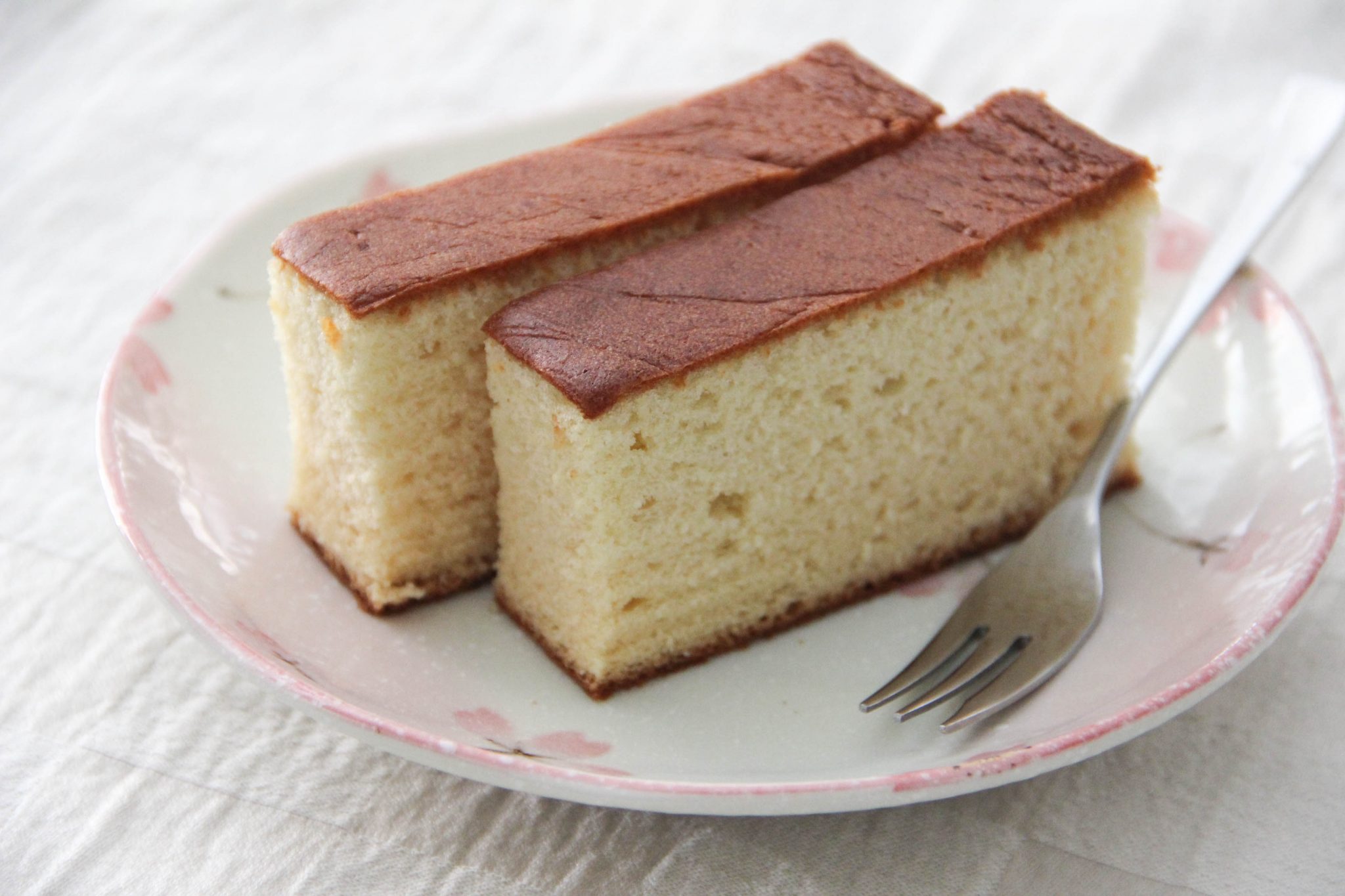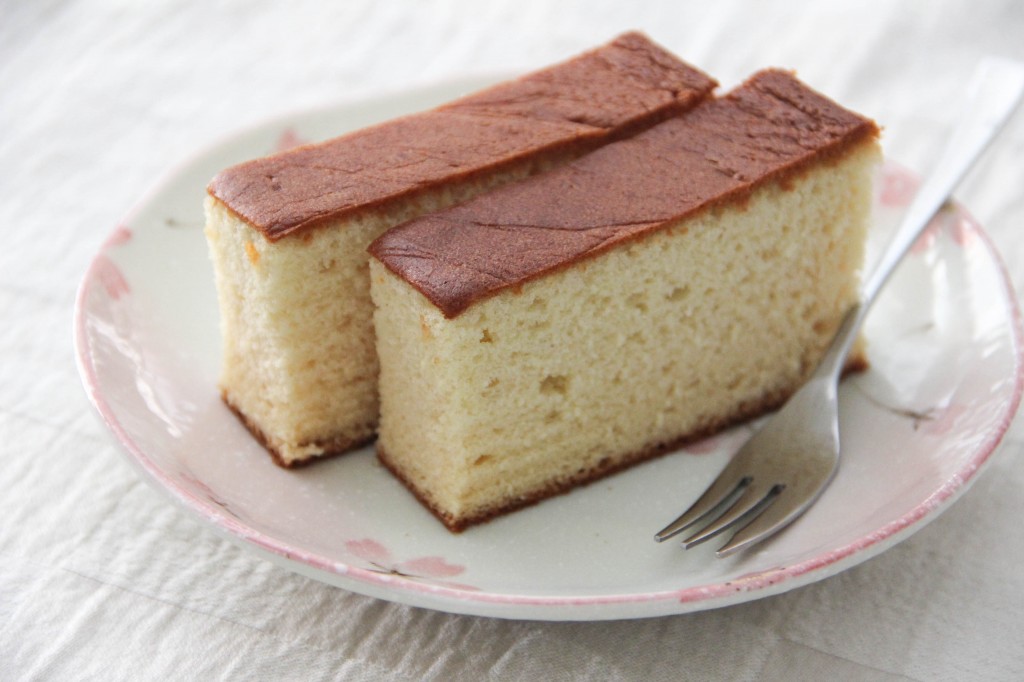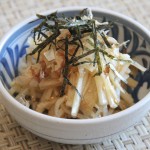Kasutera (Castella) is an old-fashioned Japanese sponge cake that is loved by everyone from the young to the old. It is sweeter and moister than western sponge cakes which are often designed to be eaten with cream or some kind of frosting. You can eat Kasutera as is, and it is perfect for tea time with green tea.
It is said that the original Kasutera cake was brought to Kyushu, the southern island of Japan, in the 16th century by Portuguese missionaries. Over hundreds of years Kasutera has been improved to Japanese tastes, and it has become today’s Kasutera. It is sweetened with sugar and honey or gooey syrup like corn syrup to make the cake very moist. Also the substantial amount of sugar and syrup gives the Kasutera’s signature look of a dark brown top which is the favorite part of the cake for a lot of people (I peel the brown skin off and eat it first!). Kasutera is soft but chewy in texture, different from the sponge cakes in western countries. Flour with higher gluten content such as bread flour is used to achieve this result. Still, it is a very light cake, and there is no fat in it.
Kasutera is sold at many old established Japanese sweets stores, department stores, and even supermarkets. Prices and flavors varies widely. Expensive ones from nice stores are usually for gifts, and cheap ones from supermarkets are for everyday snacks. We can’t beat the taste of the store run by a family for generations, but our version is pretty good for home baking. It is hard to stop the urge of eating warm cake, but it is better to leave the cake wrapped for a couple of days before eating. The flavor and texture gets better if you wait.
Even though Kasutera is originally from Europe, it is a very authentic Japanese sweet today. If you aren’t sure you want to jump right in to red bean paste cakes yet, this might be an easier starting point for Japanese desserts.

Kasutera (Castella) Recipe
Equipment
- 1 9" x 9" cake pan 22 cm x 22 cm
Ingredients
- 7 eggs (large, room temperature)
- 1 1/4 cup sugar
- 1/4 cup milk
- 1/3 cup honey
- 1 1/2 cup bread flour
Instructions
- Heat the oven to 350F (175C).
- Beat eggs in a stand mixer, adding sugar in 3 parts over about 10 minutes.
- Mix milk and honey in a separate bowl, then heat to lukewarm until the honey melts.
- Sift the bread flour and set aside.
- Add half of the milk mixture to the egg mixture and mix for a few seconds. Add half of the bread flour and mix. Add the rest of the milk and honey, and mix, then lastly add remaining bread flour and mix for 2-3 minutes. Give a good mix by hand with spatula.
- Line a 9″X9″ (23cmX23cm) baking pan with parchment paper. Pour the cake batter in the pan (if you have leftover batter, bake in another small container). Bake at 350F (175C) for 10 minutes, then lower the temperature to 320F (160C) and bake another 30-40 minutes. Cover the top with aluminum foil if it is browning too much too soon.
- Take the cake out from the oven and immediately drop the pan from a height of about 5″ (12.5cm) to release the air in the cake to avoid collapsing.
- Spread plastic wrap on a flat surface, cool the cake top side down on the plastic. Wrap it with plastic after it has completely cooled.



48 Comments
You call for 7 eggs. Are the eggs medium size? what weight of eggs is needed?
Claude,
we use large eggs. It weighs about 50g each.
Does the cake rise
What size eggs did you use for this recipe? The only egg size that is readily available in my house are large and extra large ones. I am just worried about changing the texture of the cake with too much egg. Thank you!
Min,
usually large eggs are used in recipes unless otherwise indicated. It is good for you to be cautious about measurements, especially for baking.
I loved this recipe, my kasutera was so spongy! I made it last week and I will do it again.
Thank you!
El Gato Confite,
glad you liked our Kasutera Recipe. Try our Dorayaki recipe too!
Greetings! I made this recipe yesterday and it turned out beautifully! I didn’t have a square pan so I used my 9″ spring form and it looks just as amazing in circular form. I also measured all ingredients using the weights provided. The cake is absolutely delicious! Thank you for posting this recipe and I enjoyed reading the history of Kasutera!
I’m glad you liked our Kasutera recipe! It’s my favorite dessert too.
Can I use all purpose flour instead?
Daniela,
if you do, you may not be able to get the texture of Ksutera.
I LOVE this website! I just found it yesterday and I am so excited to make all theses recipes. I lived in Okinawa, Japan for 3 years and miss the food very much. Thank you, as well, for making videos to go along with these recipes…very helpful! Now I can have authentic Japanese food at home without having to pay the ridiculous prices at the restaurants.
Teresa,
you’re welcome. Come back for more videos.
I also forgot to ask, is Japanese sugar different than american sugar? The sweets I had out there were perfectly sweet but not to sweet like in america, and it had a different taste as well.
Teresa,
we use granulated sugar.
I made Castella (Kasutera) following this recipe, and it tastes exactly like the store bought one. The texture came out really chewy, which i like, after storing it in the fridge for 24 hours. It was a little more difficult to handle, and cut since it feel really spongy, and sticky at the same time, but again, i’m very happy with the end result. I will keep making it. This recipe is a winner.
KK,
thanks for trying our Kasutera recipe! We like it too.
Can you use baking spray instead of parchment paper?
Sarah,
no, you need parchment paper for this. As you can see in the video, we line with taller parchment paper than the baking pan because the batter of Kasutera may rise higher than the height of the pan.
Hello. I would like to ask what are the nutitional facts on this recipe?
Thank you 🙂
Jewella,
we don’t have the nutritional facts on any of our recipes. If you would like to know, you could try adding all nutritional facts from the ingredients’ containers (Kasutera only has eggs, sugar, milk, honey and bread flour).
I followed the recipe but the result, while it seemed to be some sort of cake, was not very much like castella cake. It didn’t have the brown top layer, nor did it rise much, or even rise flat as it was supposed to. It wasn’t very spongy either but this I assume would mean the eggs weren’t beaten well enough. I do live at a higher altitude so that could potentially be a factor as well but I’m fairly certain that I may just be completely imcopetent at baking anything that isn’t cookies. (I did use bread flour and wax paper was used as an alternative to parchment paper when none could be found on hand.)
Andrew,
sometimes first time you make something, it may not come out quite the way you expect, especially with baking. You’re quite right, you need to beat eggs very well until very fluffy (please see the texture on the video). I don’t know very much about high altitude baking, but you may need to adjust something to suit your condition (temperature and etc.). Please don’t get discouraged, and try again!
Firstly, I would like to thank you for not only taking the time to blog and record such wonderful recipes, but also replying too! I’m sure it takes a lot of time and I really appreciate it.
A friend of mine bought a Kasutera cake that had a little design imprinted on it. I was wondering if you happen to know how that was done. Was it a little wood or metal piece put on to keep the area from baking all the way? If so, where would you purchase such an accessory? Thank you for your time and consideration.
Alisha,
I don’t know, but may be using Yakigote (like branding iron).
If we use a handheld mixer, will the cake batter still turn out like that? because I don’t have a stand mixer.
Iffah,
yes. Beat until you can get the thick texture.
I’ve made this cake several times and it really impressed my Japanese mom! I tried adding 2 tbsp of matcha and it was a very tasty variation. Thanks for the recipe (its my go to cake now) and I love your website and videos!
Julian,
glad you liked our Kasutera recipe! I like Matcha Kasutera too!
Hi, I’m japanese too! i love this recipe so much, my mum has never tried making Kasutera before, but my Ojisan loves it! It’s currently still in the oven, however it is quite runny, although i followed this recipe, so i was wondering if it was the products that i bought were different as I live in the Uk?
lina,
did you whip eggs until thick? Hope it comes out good.
Hi !
Grew up in Japan and Kasutera was one of my favorite pastry !
Noriko, I would like to know if I can use a bread loaf mold rather than a square as indicated ?
7 eggs seems a lot ! As you said 50grs approx ? Should I weight as I crack them ?
Thanks !
Sylvia92,
The shape should’t matter, but if you change the volume, you’ll need to adjust the recipe measurements. I don’t know your actual pan size, so it’s hard to say.
In our original recipe, we use a 23cm square pan with 5cm hight (approx.).
The volume of the pan is 23cm X 23cm X 5cm = 2645 cm3
You can calculate your pan’s volume and find out if you need to divide or multiply.
Hi,
Thank you for this recipe. This is by far the easiest recipe for honey castella cake that I have tried, and the result is wonderful! I said easiest because other recipes require you to separate egg white and egg yolk. While by doing so you get a fluffier texture instead of a chewy taste like this one, I find it quite difficult to achieve an evenly baked structure. With your recipe, the cake comes out nicely just like the picture shown on top of this recipe. Than you!
Hi, I just made this recipe but my cake didn’t rise very much and wouldn’t cook properly no matter how long I left it in the oven. I was just left with a tough, hard crust and uncooked middle 🙁
Thank you for the great recipe.
It was very easy to make with the kitchen aid.
Came out delicious, moist and chewy my 2.5 year old was very happy.
Thank you for these wonderful videos and brilliant website!
I’m going to try this recipe today and I was wondering where to store the cake while waiting for it to be “ready”… shall I put in the fridge (as somebody has mentioned in the comments)? And how long?
Thank you!
Hello there again! I have already made Kasutera twice, and it was extremely good! My three year old boy loved it! I made it for his birthday and he was super happy…
Regard my doubts about storing: I left it wrapped in film and it kept soft and fresh, so in case anyone else was wandering… 🙂
Just made it but did not rise fully; only half rose. What could have happened as the recipe was followed? Used an electric hand beater and worked the mix for more than 15 minutes.
I’ve made this twice now and they both turned out pretty good! I just can’t seem to get the nice dark brown color on the top. It’s always more of a blond color. It still tastes great but I’m wondering if I’m doing anything wrong?
Hi, really appreciate your recipe, my first time was very successful. However, I found a bit sweet for my own taste, is that ok to reduce the amount of sugar for this recipe? Thanks in advance.
Hi, I was wondering if I wanted to add sugar crystals at the bottom of the cake, what are some the tips and tricks that it won’t melt in the end. I made it twice already using sugar crytals but it all failed 🙁
Hello again ☺️! Another question is, if I wanted to make a chocolate flavor out of this spongy moist castella cake recipe what is the measurement for the coco powder? Thank you!
I have tried this recipe several times and I love it. But sometimes it is spongy on the upper part but very heavy dough like on the bottom part. The results vary every time. What could I be doing wrong?
Hi. At what internal temperature is the cake done baking? (I use a probe thermometer to check the exact doneness)
Also, when I whip the eggs, they become very airy and gain volume. But after I add flour and mix the batter deflates a lot, so I am afraid to mix it the full 2-3 minutes as the batter will become so deflated. Do you just ignore this? Does the cake still rise well? Or should I mix the batter less after adding flour?
Hi, I’d like to try your recipe, but I have a question, at what speed I’m supposed to beat the eggs in the mixer??? 10 minutes at high speed (10 on a Kitchenaid stand mixer) or a little slower (6-7)? Thank you very much.
Kasutera is the best dessert I can do. Everybody in my familly love it. Thanks for your recipe.